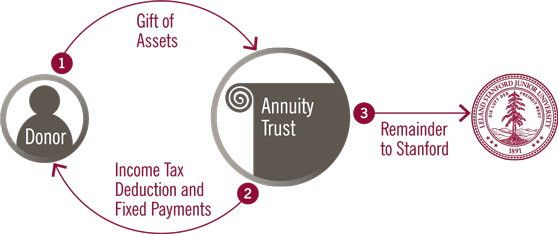Charitable Remainder Annuity Trusts
You can take care of yourself and take care of Stanford with a charitable remainder annuity trust. Through this arrangement, assets are irrevocably transferred to a trustee, who then makes fixed annual payments to you and/or other beneficiaries.
At the end of the trust term, the assets remaining in the trust are distributed to Stanford for the purpose you designate.
When you establish a charitable remainder annuity trust, you and the trustee agree to the amount of the annual payment to you and/or other beneficiaries. The amount of the annual payment must be at least five percent of the trust assets’ initial fair market value and is generally taxable to the beneficiaries.
This type of trust may appeal to older beneficiaries who appreciate knowing exactly how much they will receive each year and are not as concerned about the effects of inflation over time. Stanford serves as trustee of many charitable remainder unitrusts.

Benefits
Receive fixed annual payments
Pay no immediate capital gains tax on the transfer of appreciated assets
Federal, and possible state, income tax charitable deduction
Reduce or eliminate estate taxes
Make a gift to Stanford
This might interest you if...
You want to make a gift to Stanford and you:
Want to receive fixed annual payments for life
Have assets that you are able to give away. Assets that work especially well include:
Cash or funds earning low interest rates
Appreciated securities
Have a large part of your portfolio in one company and want to diversify your investments
Would like to have a charitable remainder annuity trust managed by Stanford
Want to reduce your current income taxes with an income tax charitable deduction
Assets used
Usually cash or appreciated securities.
Contact us
If you are interested in learning more about creating a Stanford charitable remainder annuity trust, please contact us. We would be happy to provide you with information about how a charitable remainder annuity trust would work for you based on your circumstances.
People considering a planned gift should consult their own legal and tax advisors. The staff in the Office of Planned Giving are happy to speak with advisors as well.
Charitable remainder annuity trust
Susan Jones, age 85, owns securities worth $300,000, which she bought many years ago for $20,000. These assets pay cash dividends of $6,000 (2 percent).
Susan is in the 35 percent income tax bracket and the 15 percent bracket for capital gains taxes. She would like a higher return on her securities, but if she sells the stock, then she would owe $42,000 in capital gains tax.
By transferring her shares to a Stanford charitable remainder annuity trust with a 6 percent payout, she increases her current income to $18,000 and avoids paying any immediate federal capital gains tax, even if the university decides to sell the securities now or in the future. In addition, she receives a charitable income tax deduction of approximately $190,000 (based on an IRS discount rate of .6 percent).
When the trust comes to an end at her death, the remaining assets in the trust will support undergraduate scholarships at Stanford, according to her wishes.